ISSN ONLINE(2278-8875) PRINT (2320-3765)
ISSN ONLINE(2278-8875) PRINT (2320-3765)
Rooble1, S.Chatterji2, Shimi S.L.3
|
| Related article at Pubmed, Scholar Google |
Visit for more related articles at International Journal of Advanced Research in Electrical, Electronics and Instrumentation Engineering
In this paper a low voltage, low cost & high efficiency based solar maximum power point tracking system for green house applications is presented. The main controlling element is the micro controller programme in c language in order to extract maximum solar power point. In addition we use buck converter for MPPT. Further this maximum power is utilized to drive pumps and fans of green house.
Keywords |
| Maximum Power Point Tracking, Green House, Microcontroller. |
INTRODUCTION |
| The world constraints of fossil fuels reserves and the ever-rising environmental pollution have impelled strongly during last decades the development of renewable energy sources (RES). The need of having available sustainable energy systems for replacing gradually conventional ones demands the improvement of structures of energy supply based mostly on clean and renewable resources. At present, photovoltaic (PV) generation is assuming increased importance as a RES application because of distinctive advantages such as simplicity of allocation, high dependability, absence of fuel cost, low maintenance and lack of noise and wear due to the absence of moving parts. Furthermore, the solar energy characterizes a clean, pollution free and inexhaustible energy source. In addition to these factors are the declining cost and prices of solar modules, an increasing efficiency of solar cells, manufacturing-technology improvements and economies of scale. Photovoltaic modules are interconnected assemblies of photovoltaic cells (solar cells) packaged in a weather tight housing. Modules are rated and called out by their wattage as measured under factory controlled Standard Test Conditions (STC is equal to 1000 W/m2 at 25âÃâæC and 1.5atm). In addition, every module has a maximum voltage (Voc) and current (Isc). These characteristics are used by solar designers to create an efficient PV system. Commercially available photovoltaic modules come in three primary types: |
| Polycrystalline (13-15% efficiency) |
| Amorphous (thin film) (5-7% efficiency) |
| Monocrystalline (14-17% efficiency) |
RENEWABLE ENERGY |
| India is determined to become one of the world’s leading clean energy producers. The Government of India has already made several provisions, and established many agencies that will help it achieve its goal. Renewable Energy, excluding large hydro projects already accounts for 9% of the total installed energy capacity, equivalent to 12,610 MW. In combination with large hydro, the capacity is more than 34%, i.e. 48,643MW, in a total installed capacity of 1,44,980 MW. The following Fig. 1 shows the percentage of renewable energy generation in India. |
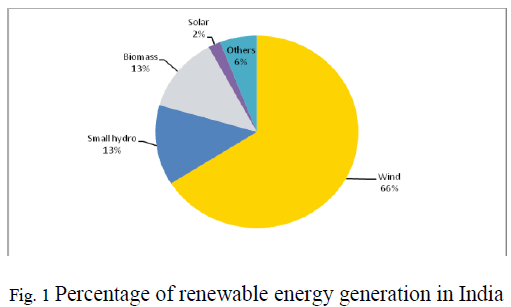 |
GREEN HOUSE |
| A greenhouse (also called a glasshouse) is a building in which plants are grown. These structures range in size from small sheds to industrial-sized buildings. A greenhouse is a structural building with different types of covering materials, such as a glass or plastic roof and frequently glass or plastic walls; it heats up because incoming visible solar radiation (for which the glass is transparent) from the sun is absorbed by plants, soil, and other things inside the building. Air warmed by the heat from hot interior surfaces is retained in the building by the roof and wall. In addition, the warmed structures and plants inside the greenhouse re-radiate some of their thermal energy in the infrared spectrum, to which glass is partly opaque, so some of this energy is also trapped inside the glasshouse. |
PHOTOVOLTAIC EFFECT |
| When irradiance hits the surface of solar PV cell, an electrical field is generated inside the cell. As seen in Fig. 2, this process separates positive and negative charge carriers in an absorbing material (joining p-type and n-type). In the presence of an electric field, these charges can produce a current that can be used in an external circuit. This generated current depends on the intensity of the incident radiation. The higher the level of light intensity, the more electrons can be unleashed from the surface, the more current is generated. The design of effective and profitable facilities on the basis of solar modules is especially important. Software dedicated to the simulation of photovoltaic systems can realize extensive and precise analyzes, but they generally do not allow the user to modify the algorithms. |
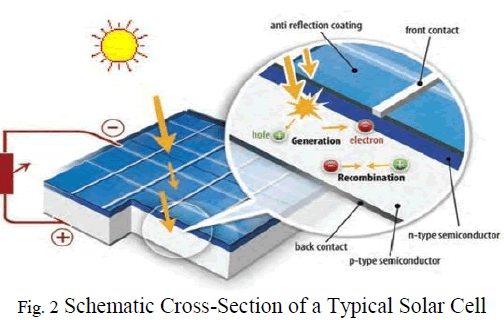 |
MAXIMUM POWER POINT TRACKING |
| The peak power is reached with the help of manual tracking or automatic tracking .Manual tracking is not possible so automatic tracking is preferred to manual tracking. An automatic tracking can be performed by utilizing various algorithms. |
| (i) Perturb and Observe |
| (ii) Incremental Conductance |
| (iii)Constant Voltage Method |
| The algorithms are implemented in a microcontroller or a personal computer to implement maximum power tracking[4]. The algorithm may change the duty cycle of the dc/dc converter to maximize the power output of the module and make it operate at the peak power point of the module. Similarly inverter modulation can be varied and the maximum power point can be obtained. |
HARDWARE |
| 1. Solar Panel: It is a packaged, connected assembly of photovoltaic cells. Here a 17V 10W solar panel will be used. |
| 2. Dc Motor (20 rpm ) : A dc motor is a mechanically commutated electric motor powered from direct current (dc). It is used for rotating the Solar Panel according to sunlight. |
| 3. Relay (6V dc): A relay is an electrically operated switch. Many relays use an Electro-magnet to operate a switching mechanism mechanically. Relays are used where it is necessary to control a circuit by a low-power signal (with complete electrical isolation between control and controlled circuits), or where several circuits must be controlled by one signal. Here it is used for controlling water pump and water air pump. |
| 4. Sensors: Temperature sensors are devices used to measure the temperature of a medium. There are two kinds of temperature sensors contact sensors and non-contact sensors. However, the three main types are thermometers, resistance temperature detectors and thermocouples. All three of these sensors measure a physical property (i.e. volume of a liquid, current through a wire), which changes as a function of temperature. |
| 5. Humidity Sensor : is the presence of water in air. The amount of water vapor in air can affect the plants growth . The presence of water vapor also influences various physical, chemical, and biological processes. |
| 6. Day and Night Sensor : A photoresistor or light dependent resistor (LDR) is a resistor whose resistance decreases with increasing incident light intensity; in other words, it exhibits photoconductivity. A photoresistor is made of a high resistance semiconductor. high frequency, photons absorbed by the semi-conductor give bound electrons enough energy to jump into the conduction band. The resulting free electron (and its hole partner) conduct electricity, thereby lowering resistance. |
| 7. ADC0808/ADC0809: It’s a 8-Bit μP compatible A/D converters with 8-channel multiplexer .The ADC0808, ADC0809 data acquisition component is a monolithic CMOS device with an 8-bit analog-to-digital converter,8-channel multiplexer and microprocessor compatible control logic. The 8-bit A/D converter uses successive approximation as the conversion technique. The converter features a high impedance chopper stabilized comparator, a 256R voltage divider with analog switch tree and a successive approximation register. The 8-channel multiplexer can directly access any of 8-single-ended analog signals. The device eliminates the need for external zero and full-scale adjustments. Easy interfacing to microprocessors is provided by the latched and decoded multiplexer address inputs and latched TTL TRISTATE ® outputs. |
| 8. KIA7805AP: It is a three terminal positive voltage regulator suitable for CMOS, TTL and other digital IC’s power supply.It has internal thermal overload protection and internal short circuit current limiting features. |
| 9.Microcontroller :Microcontroller (AT89S52) is used to control and interface the Relays , Sensors and Motor.The AT89S52 is a low-power, high-performance CMOS 8-bit microcontroller with 8K bytes. |
METHODOLOGY |
| The prototype model of a solar microcontroller based greenhouse working on basis of maximum power tracking will be made in the following steps: |
| Complete layout of the whole set up will be drawn in form of a block diagram. |
| Day and night sensor will first sense the condition and give its output to the microcontroller. |
| The photovoltaic panel will be mounted at an optimum angle of 67 degree in the month of April for the latitude of Chandigarh as referred from Solar Electricity handbook 2013 edition solar electricity from the vertical as on a d.c. motor driven by a driver I.C. such that the panel moves and the microcontroller checks the output voltage at various points . |
| Identification of points where maximum voltage and hence maximum power received by the solar panel. |
| Maximum power will be detected by MPPT Algorithm developed, then fed to Analog to Digital converter and stored in microcontroller. |
| The motor and hence the panel will be stopped when maximum power will be received by the solar panel and hence will start charging the battery . |
| A check on soil, humidity and temperature can also be kept using sensors and solar energy stored can be used to run a water pump and water air pump so as to maintain different parameters at an optimum level [5]. |
PROPOSED ALGORITHM FOR MPPT |
| Identify the input variables namely temperature, solar radiation , voltage and current obtained on solar panel and humidity condition using temperature sensor ,light dependent resistor and humidity sensor respectively. |
| Mount solar panel at 82 degrees to vertical on dc motor as referred by solar PV Panel tilt calculator 2013 for Chandigarh for the month of JUNE as available online and connect battery to panel to store power. |
| Make RAM of micro-controller empty. Initialize starting data in micro-controller. Write LCD information in micro-controller . |
| Check day /night condition using a sensor . |
| If day then micro-controller will start rotating the motor and hence the photo voltaic panel to track the sun at a specific angle . The angle of rotation being approximately in the range of 5 degree to 30 degree each time. |
| Microcontroller checks the voltage obtained at various points and compares there values and stops the panel at the maximum voltage point. |
| If the temperature and humidity is optimum then no action will take place but if temperature and humidity is more then the micro-controller switches on a air fan . |
FLOWCHART |
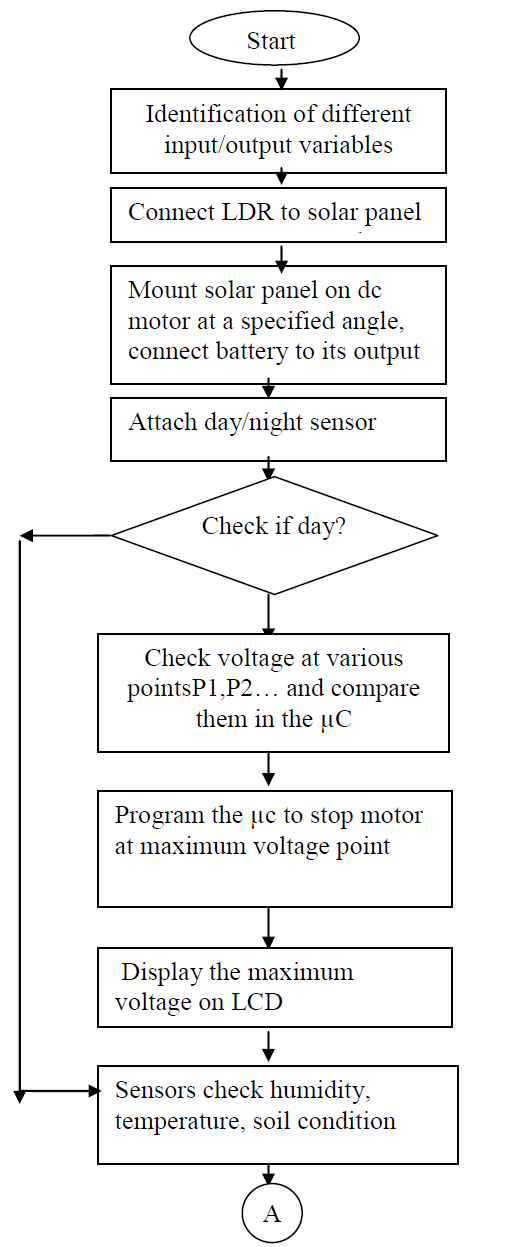 |
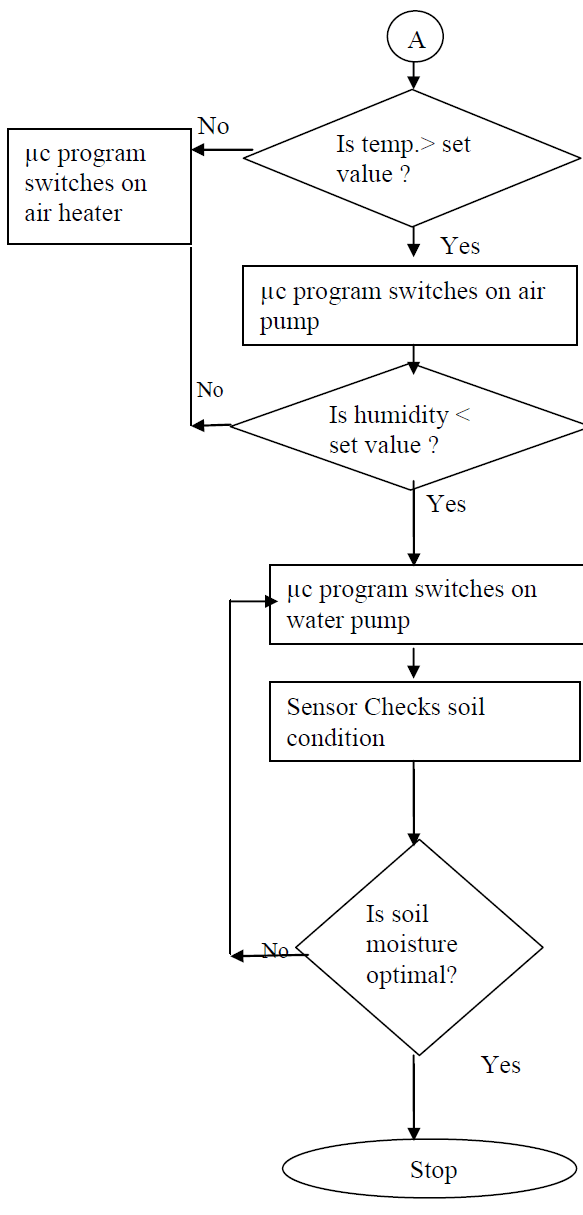 |
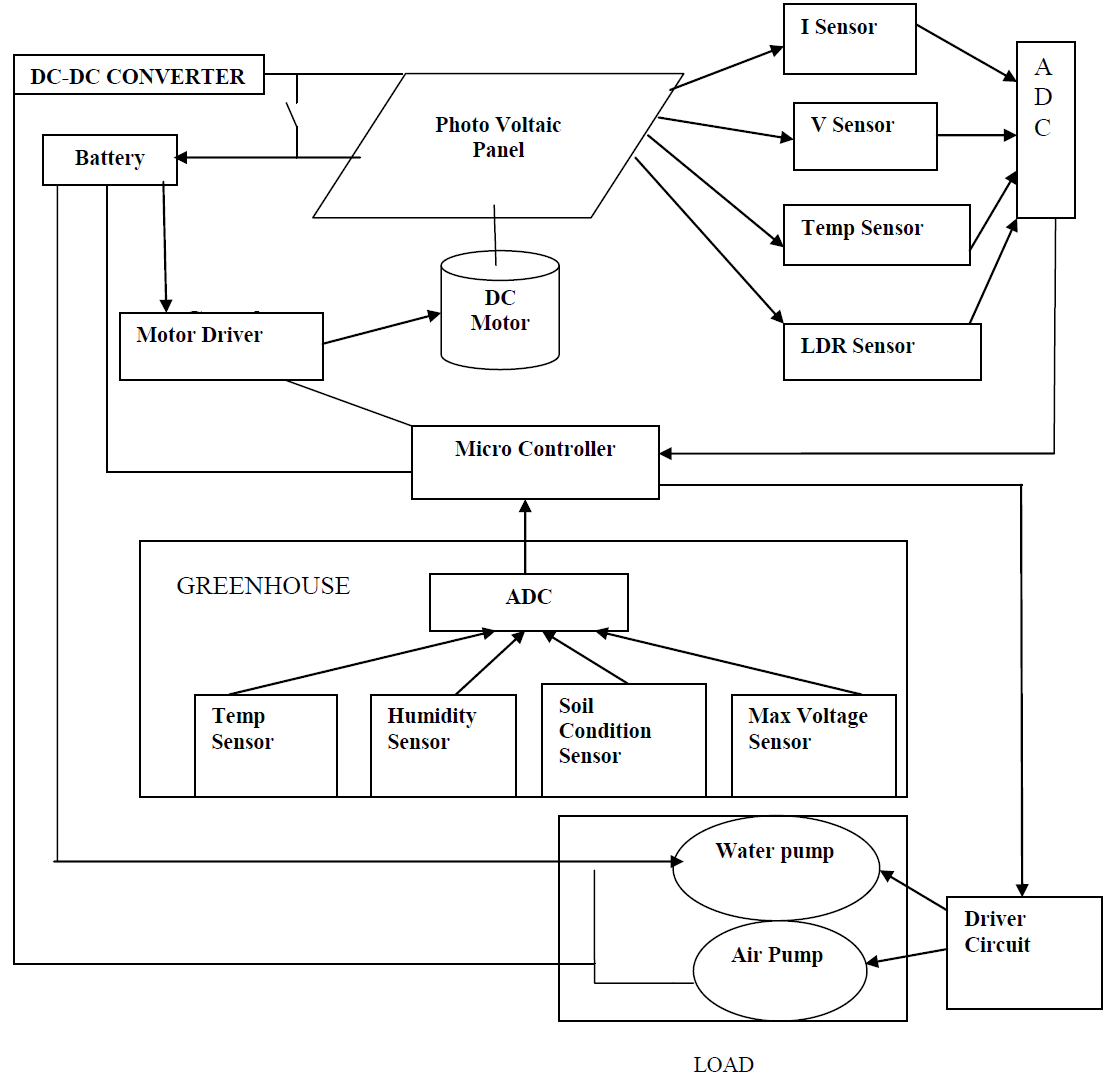 |
CONCULSION |
| After carrying out the proposed work, the investigator expects the following outcomes: |
| Development of a solar green house based on maximum solar power tracking with various parameters being controlled by a microcontroller and maintained further to an optimum value required for adequate growth of plant; using the stored solar energy only . Storage of solar energy in a battery and then its re-utilization for driving a water pump and a water air pump to maintain optimum moisture and temperature required for adequate growth of plant. An increase in output of solar panel due to the implementation of maximum solar power tracking . The proposed greenhouse is very useful for hilly areas where there is scarce sunlight in winters .The proposed greenhouse will consist of minimum hardware. And will have very fast response and will occupy minimum space It can be built even on the rooftop of houses, in highly populated hilly areas. Energy can also be stored at a large scale and maybe utilized for heating the house water in winters available in tanks of house. |
References |
|